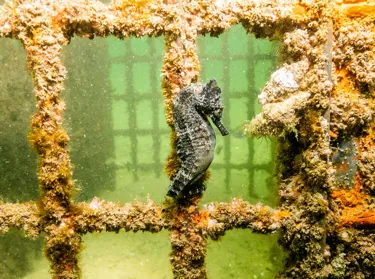The Story of Sydney’s Seahorse Comeback with the help of SEA LIFE Sydney
- Monday 9th June 2025

Did you know male seahorses carry the babies? Or that Sydney is home to one of the only seahorse species in the world listed as endangered? Meet White’s Seahorse (Hippocampus whitei), a delicate little creature found only along Australia’s east coast and a real underwater Aussie battler. These charming marine animals are masters of disguise, changing colour to blend in with their surroundings. But in recent years, they’ve faced major challenges, with habitat loss, pollution, and coastal development causing populations in Sydney Harbour and Botany Bay to drop dramatically.

Thankfully, there’s hope on the horizon. SEA LIFE Sydney Aquarium in partnership with NSW DPI Fisheries and the University of New South Wales, is leading the charge with a world first breeding and recovery program. Inside our purpose built Seahorse Breeding and Conservation Lab the only one of its kind in New South Wales marine experts carefully raise baby seahorses before releasing them back into the wild. More than 800 juveniles have already been released. Each tiny tail returned to the sea is part of a carefully planned strategy to boost wild populations and re-establish thriving colonies.

One of the coolest parts of the project? Seahorse hotels, specially designed underwater structures that act like cosy coral condos, giving seahorses a safe place to anchor, shelter and start new lives. These structures are popping up in spots like Clontarf Reserve and Port Stephens, where natural sponge gardens have declined. It’s conservation with a creative twist and proof that even the smallest sea creatures can make the biggest splash when given the chance.
Seahorse Conservation: FAQs
1. What species of seahorses does SEA LIFE work with?
SEA LIFE has successfully bred 15 different seahorse species since 2015, including rare and endangered types like the Indonesian zebra‑snouted seahorse and hedgehog seahorse
2. What is the ‘Seahorse Hotel’ and where is it located?
The Seahorse Hotel Conservation Project is based in Australia and creates safe, artificial habitats like sponge gardens and soft coral farms for seahorses in areas where their natural homes have been destroyed
3. How does SEA LIFE monitor seahorse populations?
Their expert divers regularly survey both seahorse and seagrass beds in Europe and Australia, tracking population growth and habitat health
4. Why is habitat restoration important for seahorses?
Seahorses rely on shallow seagrass meadows, sponges, and soft corals to camouflage, feed, and reproduce. Restoring these habitats helps secure their survival in the wild
5. How does captive breeding help conserve wild seahorses?
By breeding 15 species in aquariums, SEA LIFE gains insight into reproduction and rearing knowledge that supports rewilding programs and reduces pressure on wild populations
6. Can visitors see seahorses during their Aquarium visit?
Yes! At SEA LIFE London and other aquariums, there are dedicated seahorses and pipefish exhibits that highlight these conservation efforts
7. What’s contributed to the recovery of seahorse numbers?
Thanks to the Seahorse Hotel and habitat efforts, local seahorse populations have not only survived they've been observed breeding and growing stronger in the wild
8. Do seahorses really mate for life?
Many seahorse species form strong monogamous pair bonds, with some believed to mate for life. Pairs often perform daily “greeting dances” and synchronise their movements a rare trait in the animal kingdom and a favourite among visitors and marine enthusiasts alike.
9. Why do male seahorses give birth?
Yes, it's true male seahorses get pregnant! Females deposit eggs into the male’s brood pouch, where he fertilises and carries them until birth. This rare reproductive role reversal fascinates both scientists and visitors, making seahorses a popular marine exhibit worldwide.